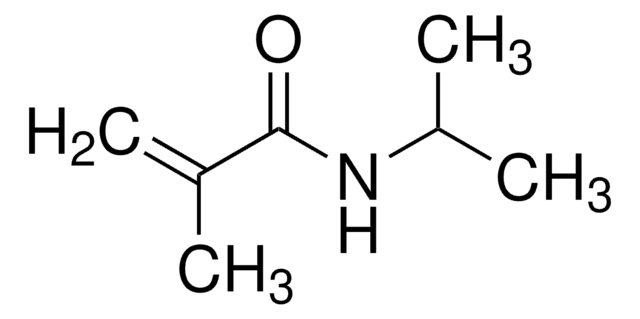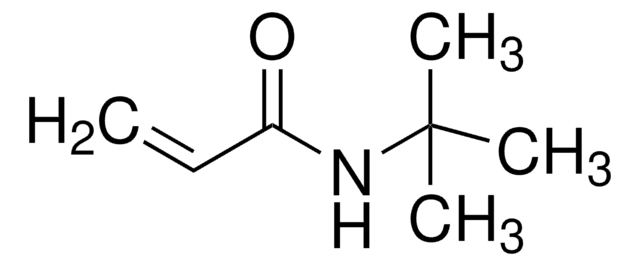731129
N-Isopropylacrylamid
≥99%
Synonym(e):
NIPAM
About This Item
Empfohlene Produkte
Assay
≥99%
Form
flakes
bp
89-92 °C/2 mmHg (lit.)
mp (Schmelzpunkt)
60-63 °C (lit.)
63-67 °C
Lagertemp.
2-8°C
SMILES String
CC(C)NC(=O)C=C
InChI
1S/C6H11NO/c1-4-6(8)7-5(2)3/h4-5H,1H2,2-3H3,(H,7,8)
InChIKey
QNILTEGFHQSKFF-UHFFFAOYSA-N
Suchen Sie nach ähnlichen Produkten? Aufrufen Leitfaden zum Produktvergleich
Allgemeine Beschreibung
Anwendung
N-Isopropylacrylamide can also be used as a key component in:
- The synthesis of self-powered multifunctional organic hydrogel based on poly(acrylic acid-N-isopropyl acrylamide) for flexible sensing devices.
- The development of a new type of flexible and stable gel electrolyte for aqueous Zn-MnO2 batteries.
- The preparation of poly(N-isopropylacrylamide/itaconic acid) (PNIPAM/IA) copolymeric hydrogels for drug delivery applications.
- The synthesis of poly(N-isopropylacrylamide) (PNIPAM) polymer for the development of a new class of polymer-grafted semiconductor devices.
Signalwort
Danger
H-Sätze
Gefahreneinstufungen
Acute Tox. 4 Oral - Eye Dam. 1
Lagerklassenschlüssel
11 - Combustible Solids
WGK
WGK 3
Hier finden Sie alle aktuellen Versionen:
Besitzen Sie dieses Produkt bereits?
In der Dokumentenbibliothek finden Sie die Dokumentation zu den Produkten, die Sie kürzlich erworben haben.
Kunden haben sich ebenfalls angesehen
Artikel
Poly(N-isopropylacrylamide), or PNIPAM, is a stimuli-responsive polymer that responds to changes in pH and temperature and has a LCST around 32 C.
Tissue engineering has become a key therapeutic tool in the treatment of damaged or diseased organs and tissues, such as blood vessels and urinary bladders.
Unser Team von Wissenschaftlern verfügt über Erfahrung in allen Forschungsbereichen einschließlich Life Science, Materialwissenschaften, chemischer Synthese, Chromatographie, Analytik und vielen mehr..
Setzen Sie sich mit dem technischen Dienst in Verbindung.












